Working for the Todd-AO Studios | Read more at in70mm.com The 70mm Newsletter |
| Written by: Dan Leimeter, Arizona, USA. All pictures October 1994 by Thomas Hauerslev, except when noted. | Date: 15. March 2005 |
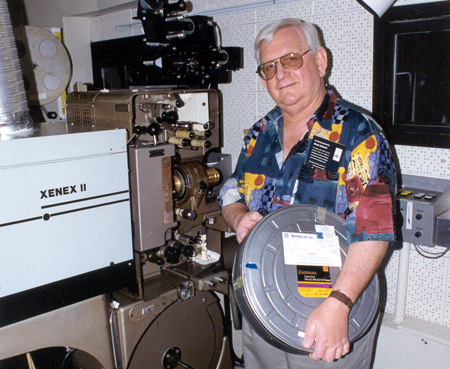 The Chief himself Dan Leimeter, April 17, 1999. Picture by Paul Rayton The Chief himself Dan Leimeter, April 17, 1999. Picture by Paul RaytonTodd-AO had been in business for over twenty years when I started to work there in 1977. Michael Todd's original idea had been to excite the theatrical audience with a huge spectacle: BIG color picture, BIG stereo sound, all coming out of one machine during presentation. 70mm film provided the vast image up on the screen, and six tracks of high-fidelity magnetic sound surrounding the audience made it seem like they were in the picture. • Go to In Memoriam - Daniel Harold Leimeter • Go to Walter Siegmund's Todd-AO History • Go to Brian O'Brien Jr.'s Todd-AO How It All Began The camera department provided the technology for the visuals, and the sound department at the studios at 1021 North Seward provided the accompanying audio. • Go to Gallery Visit to Todd-AO Studios, October 1994 In the Projection Department at 1021, we kept the big picture up on the screen so the mixers at the console could match the sound image the audience would hear to the visual image the audience would see. We had three mixing stages then: • Studio A was the big six-track room where the major features were done, • Stage B was a mono room where we did television shows and commercials, and • Stage C was an Automatic Dialog Replacement [ADR] room where actors came in to re-do their lines when the production dialog recorded on the set was not usable. When C was not being used for ADR we mixed commercials; dead stage time does not pay the bills. | More in 70mm reading: In Memoriam - Daniel Harold Leimeter Honorary membership - Dan Leimeter Gallery: Visit to Todd-AO Studios, October 1994 The 70mm Promotion Tour: Tour report #1 Tour report #2 James Horner at the Todd-AO Scoring Stage, CBS Radford, Studio City Walter Siegmund's Todd-AO History Brian O'Brien Jr.'s Todd-AO How It All Began DP70 / Universal 70-35 / Norelco AAII - The Todd-AO Projector DP70s in California (CA) The Passing of Joe Kelly Richard Vetter Passed Away |
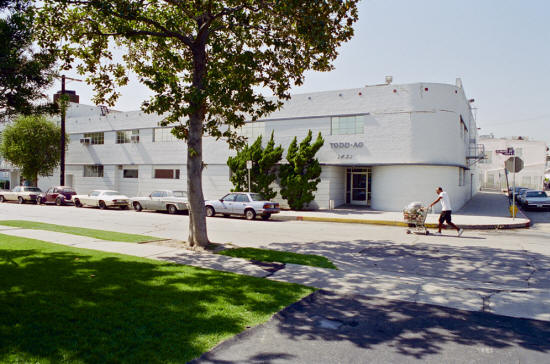 Todd-AO Main entrance 1021 North Seward Street, Hollywood. Todd-AO Main entrance 1021 North Seward Street, Hollywood. For those few who may be interested, Stage A booth had the two prototype DP70 projectors (the third prototype DP-70 was in the American Optical headquarters on the East Coast, but that's another story) with Peerless Hi-Can revolving positive carbon condenser arc lamps. These machines were originally used for mixing as well as playback, but in 1968 the industry developed the "punch-in" record technology which allowed the system to back up at any point, roll forward and punch into record on the fly, rather than going back to the head for each pass. The prototypes had curved gates and could not run in reverse, so to accommodate back-up, a Symplex XL with a Hughes Xenon lamp house was installed next to the two DP-70s in the A booth. Stage B booth had one Simplex XL and one Century 35mm projectors, each with Peerless Magnarc Type F carbon arc lamphouses. Studio C had two Centurys with Peerless lamphouses. These machines were used for mixing as well as playback. The mixers at the console on stage had control of the entire system: the recorder, the projector, and a bank of sound reproducers. When they would reverse the system, the projectionist could shut down the lamp, reach in and retrim the carbons, and restrike the arc before the system went forward again. Most of the time you made it, but on short turnarounds sometimes you didn't, and the mixers would fill the intercom with obscenities (especially if the client was out of the room). | |
Glamour of Hollywood | |
 Sound dubbers 1021 North Seward Street, Hollywood. Sound dubbers 1021 North Seward Street, Hollywood.Working in the projection booth and in the Machine Room where the recorder and reproducers were located was fun, but it was not what one could associate with the "Glamour of Hollywood". The pay was good, and the coffee was hot, but the hours were long and once you've seen a particular ten-minute reel of film over and over for hours on end it gets a bit boring. One of my well-meaning relatives once said: "Your job must be such fun; you get to watch movies all day long." I could only smile and shrug, and say that it beat working for a living. What was difficult was the eight-hour-turn-arounds; you would start at 8:00 in the morning and work until midnight. Day after day after bleeding day. These usually happened near the end of a show, the last couple of weeks when you were fighting a deadline: "The film goes to the lab next week and they just re-shot the music for the entire show!" The overtime pay was good, but it was hard on people with families. About a year after I started, the company switched over to the High-Speed Shuttle system. Earlier, everything travelled at sync speed, 24 frames per second, but with the new system everything -- recorder, reproducer and projector -- could whizz forward or backward at up to ten times sync speed. It was great, you could work on a particular piece of dialog or sound effect and then high-speed back to the head of the section and run it over again. Of course, film splices which travelled easily through the projector at normal speed would buckle or hinge at high speed and, in the twinkling of a eye, you would be at the splicer on the bench repairing damaged film while the mixer called out on the intercom "Are we ready yet? What is taking so long? God Damn It To Hell; We're Losing The Light Down Here!" Unfortunately, continued stress over time does not really build one's character, no matter what they say, it merely provides one with grey hair and a cranky disposition. | |
Modernizing and Upgrading | |
 Stage A, 1021 North Seward Street, Hollywood. Stage A, 1021 North Seward Street, Hollywood.I became Chief Projectionist at TAO in 1981, and a few years later the Naify family sold their immense holdings in the United Artists Theatre Circuit, and redirected the cash into modernizing and expanding Todd-AO. First we added two more six-track recorders to Stage A, so that we could keep multi-track dialog, music, and effects separate to facilitate changes right up to the final print master. Dolby Stereo-optical technology was making it economical for many more films to be made in stereo at that time so we gutted Stage B and made it into a first-class four-track mixing studio and a four-and-six-track playback room for checking 35mm and 70mm stereo release prints, taking some of the pressure off of Stage A. I designed a deeply curved screen for stage B, wrapped around a tubular frame, so that it just floated in space filling the entire wall of the stage. I made the curve radius 80% of the projection throw to concentrate the reflected light on the mixers and the directors seats, where it was most wanted. I designed the double-glazed projection ports with a 15 degree angle on each piece of coated glass to redirect the internal reflection (normally seen as a ghost image during credit crawls) up off the screen and onto the matte-black ceiling. Joe Kelly the Vice-President of Projection and Sound at United Artists Theatre Circuit and a truly fine man, had a pair of dual-motor DP-70s in his warehouse and offered them to me for Studio B. I tore them apart and rebuilt them with all new bearings, springs, sleeves, and gaskets. I added a switch inline with the framing lights, and motorized the take-up spindles so we could wind onto 3" plastic cores and send the prints tails out to the labs for final assembly onto shipping reels. We checked a lot of 70mm release prints in that room once we got it built. We rebuilt Stage C into a four-track mixing facility with provisions for ADR and Foley as well. Ultimately it, too, got a wall-to-wall deeply curved screen. We tore out the Century projectors and installed a hi-speed Magnatech 636 in their place, using the remaining space to slide the ADR booth back into half of the old projection booth space, which left room to install a three-mixer console in place of the old single-mixer board. And a good time was had by all. | |
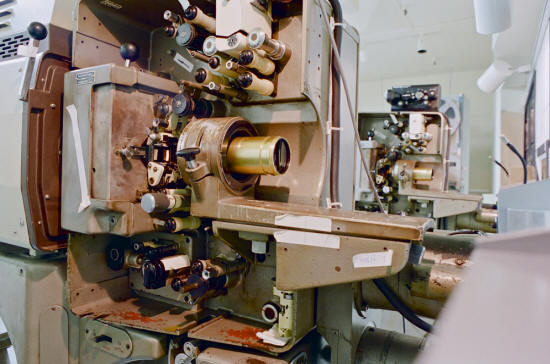 DP70 prototypes Stage A, 1021 North Seward Street, Hollywood. DP70 prototypes Stage A, 1021 North Seward Street, Hollywood.When I first came to Todd-AO we were still using the old Bausch & Lomb and Kollmorgan lenses from the 1950's; compared to the Isco Ultra-Star series, they were Coke bottles. You could focus in the center and the sides would be out; you could really see how bad it was if the end credits went out to the side masking. So, I was very fortunate that the new lens technology was there at my disposal when I became Chief Projectionist and could spec out the good stuff. The prevailing feeling at TAO in the late '70s was that we were a sound house, the money gets spent on audio gear and screw the picture -- so as long as we could see lip sync we were in business. Luckily I knew Glenn Berggren, and he knew Isco lenses, so I was able to convince my bosses (Clay Davis, head of engineering, and Fred Hynes, head of the studio; two of the finest gentlemen I have ever had the pleasure to know) that it was in their best interest to invest in the best lenses money could buy. When your picture looks good, you look good. Also, Dick Vetter showed me that it was better to use a longer focal length lens with a beam spreader than to use the focal length lens one would usually use to fill the screen. For instance, if you need an effective focal length lens of 50mm to fill your screen, it's much better to use an 80mm or an 85mm prime lens with a Magna-com attachment up front because it draws the first or prime lens element further away from the film plane. Therefore any movement of the film out of the film plane (such as from buckling or embossing) will be a much smaller percentage of the distance from the film plane to the prime element, and your image on the screen will stay in focus a lot more than if you used a 50mm lens which sat much closer to the film plane. | |
Expanding the Activities | |
 Scoring stage at the CBS lot in Studio City. Scoring stage at the CBS lot in Studio City.In 1982, or was it '84, we acquired the Glen Glenn facilities to expand more into the TV market. That gave us stages in the 900 building on North Seward Street, as well as stages at the CBS lot in Studio City. We poured a lot of money into revamping the stages at 900 [North Seward Street], making them more efficient and user-friendly, and completely redesigned stages R, S, T, and the Scoring stage at CBS, adding a video transfer room in the process. • Go to James Horner at the Todd-AO Scoring Stage, CBS Radford, Studio City When the Skywalker South studios in Santa Monica came on the market they quickly became Todd-AO West, and some of our mixers moved over there to be closer to their homes on the west side. We completely remodelled the older stages in the complex on Bundy, and redid Stage 3 in the newer building on Olympic. TransAudio Studios in Manhattan soon came on board as Todd-AO East, and Hollywood Video on Sunset Blvd. was quickly added to the family. An editorial house in Atlanta and a video house in Santa Monica also were added. In 1997 or thereabouts Sound One in mid-town Manhattan joined the Todd-AO family of companies. With that acquisition, TAO held both of the major motion picture sound mixing facilities in New York. If there was a big film mixing on the east coast, Todd helped in its creation. | |
Compact Distribution Print | |
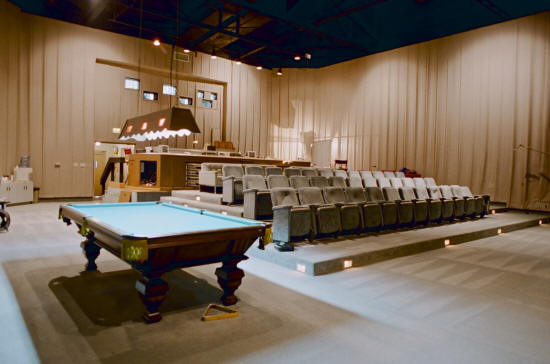 Stage A, 1021 North Seward Street, Hollywood. Note the pool table. Stage A, 1021 North Seward Street, Hollywood. Note the pool table.In addition to our usual studio duties, a small group of us (Clay Davis, Bob Weitz, and myself) were asked to work directly for Salah Hassanein, the Chairman and CEO [Chief Executive Officer] of Todd-AO, along with Dick Vetter and Darryl Grey of Todd-AO Camera and Bob Pinkston of UATC to develop the Compact Distribution Print. Everyone dedicated themselves to the project, and we honed the concept and refined the technology and we made it work splendidly. We were in the final stages of demonstrations to the industry when our major stockholder passed away. • Go to Compact Distribution Print by Todd-AO In 1999, Marshall Naify died. Marshall was the head of the family that had owned controlling interest in Todd-AO since the 1950's, and when he passed away his family was eager to cash in their tremendous assets in the profitable company that was a leader in it's field. The project was mothballed and put into UATC vaults, while the Naify family looked for a buyer. | |
Killing the Golden Goose | |
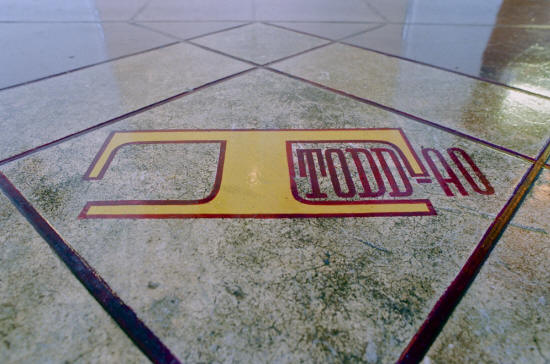 Todd-AO Sound Studios entrance floor, 1021 North Seward Street, Hollywood. Todd-AO Sound Studios entrance floor, 1021 North Seward Street, Hollywood.At just that time [1999], Liberty Media (a much larger fish in the financial food chain) came along looking to establish a beachhead in what they saw as the cash cow of the future - interactive television. Todd-AO had sound mixing facilities for film and television, as well as video imaging and editorial companies under it's belt, so they up and bought it. Then they purchased other, smaller, media companies in the Hollywood area in order to control as much of the market as they could get. Since their interest was in interactive television, Liberty had little interest in, or respect for, large screen theatrical productions, so they picked from among the smaller companies to find television-minded executives to run the newly collected companies. Soon, Todd-AO was under the revengeful thumb of former competitors who had full control on it's future existence. Soon, the name was gone, the people were gone, and the facilities were gone. Interestingly, most of the people responsible for killing the golden goose were themselves put out of the company. Interactive television was an idea way ahead of it's time, and the bonehead who championed the concept left Liberty under a cloud long before I had to retire. When I retired about a year and a half ago [August 2003, ed], the Todd-AO name was as dead as Kelsey's goat. People at the company were told in no uncertain terms that
About a year ago [Early 2004, ed] someone in upper-level management realized that they had a goldmine in the old Todd-AO name, and they resurrected it and have been using it ever since. All of the sound facilities now carry the Todd-AO name, and all of the editorial facilities carry the Soundelux name. The names "Liberty Livewire" and "Ascent Media" have both been swept under the rug | |
70mm films mixed at Todd-AO | |
• Go to Todd-AO Premiere List • Go to Presented in 70mm Dolby Stereo • Go to Films blown up to 70mm Films I know for sure we made the 70mm prints, I don't remember whether we did the mix. We worked on so many films that it's hard to remember them all at one sitting. So many years ago, so much water under the bridge by now. | |
Interesting people I met at Todd-AO | |
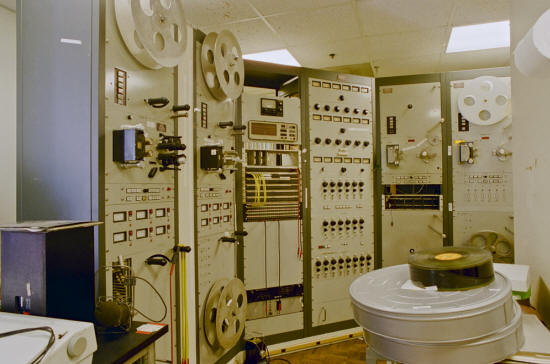 Magnatech 70mm film print recording dubbers, 1021 North Seward Street, Hollywood. Magnatech 70mm film print recording dubbers, 1021 North Seward Street, Hollywood.You asked which interesting people I had encountered during my incarceration at Todd-AO; unfortunately, many of the people who interested me were not household names - they were mostly engineers, mixers, editors, writers, associate producers (people who, for screen credit, will associate with a producer) and other below the line staff. Once in a great while, you see, in the wonderful world that is the motion picture industry, a producer will award "associate producer" credit to one or two of his staff in lieu of proper and adequate monetary remuneration. But only on special occasions, like weekdays. But, of course, I did rub elbows with some fine folk whose names might well be recognizable to your readers. Sydney Pollack was always a joy to work with, and it was thrilling when Bette Midler was on Stage A. We were all proud that Barbra Streisand did a number of her films with us, as did John Landis and Bob Zemickis. I admit to being a bit slack-jawed when I met these actor/comedians whose work I particularly loved: Vincent Price, Sid Caesar, Danny DeVito, Dick Van Dyke, and Jason Alexander. In 1992, I was very happy to have the opportunity to assist Mai Zetterling in repairing a damaged print of a film she had directed, "Amorosa", so she could show it in an as-perfect-as-possible condition at an industry screening. I had always enjoyed her acting, and I was thrilled to spend time with her; she was a wonderful lady. I later received a note from the Swedish Information Office thanking me on her behalf; I had it mounted and framed, and it hangs next to my Tech award from the Academy. | |
My Retirement | |
| HOME, SWEET HOME! Lottsa birds, lottsa squirrels, and the occasional family of deer strolling through the property. We always smile and wave, and softly say "Hi, Bambi!". Very woodsy, very quiet, and no noisy freeways within six miles in any direction. In these days, life don't get much better than that. As the old adage says, "Living well is the best revenge." Picture by Dan Leimeter It was an exciting and fun ride while it lasted, and for me it lasted for 26 years [1977 - 2003]. The hours were long, the pay was good, and I got to meet some very interesting and entertaining people along the way. So what's not to like? • Go to Honorary membership - Dan Leimeter December 2019 update: I went onto Google Earth a while back, just to take a look at the old neighbourhood in Hollywood. The Glenn Glen Sound Building is still there, but the old Todd-AO buildings are gone. Clay Davis told me that Hollywood General Studios (which was located just to the west of us) bought the property, ripped it all down and built a high-rise office building complex on the sight. When you get a moment, go on the Google Earth and do a quick stroll through the old neighbourhood where we all did so much work in 70mm. It's all gone, no more small town atmosphere; it reminds me of walking around mid-town Manhattan, with all of the high-rises. One could get a crick in their next just looking up at the top floors! | |
| Go: back - top - back issues - news index Updated 20-10-24 |
